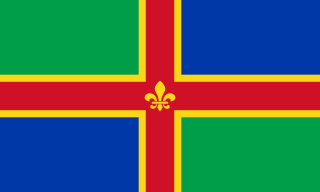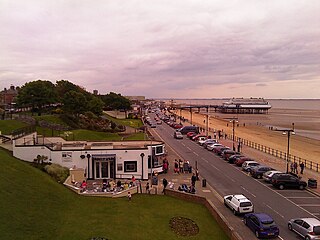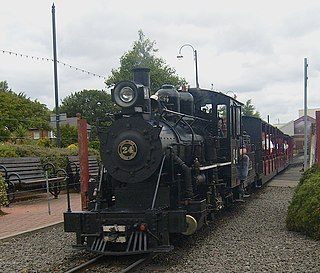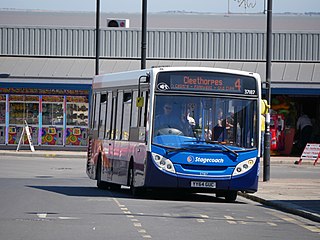
Lincolnshire is a county in the East Midlands of England, with a long coastline on the North Sea to the east. It borders Norfolk to the south-east, Cambridgeshire to the south, Rutland to the south-west, Leicestershire and Nottinghamshire to the west, South Yorkshire to the north-west, and the East Riding of Yorkshire to the north. It also borders Northamptonshire in the south for just 20 yards (19 m), England's shortest county boundary. The county town is the city of Lincoln, where the county council is based.

North East Lincolnshire is a unitary authority area in the ceremonial county of Lincolnshire in England. It borders the unitary authority of North Lincolnshire and the non-metropolitan county of Lincolnshire, the three areas making up the ceremonial county. The population of the Unitary Authority at the 2011 Census was 159,616. North East Lincolnshire is part of the Yorkshire and the Humber region. The borough includes the towns of Immingham, Cleethorpes and Grimsby.

Cleethorpes is a seaside town on the estuary of the Humber in North East Lincolnshire, England with a population of 38,372 in 2020 []. It has been permanently occupied since the 6th century, with fishing as its original industry, then developing into a resort in the 19th century.

Grimsby, also Great Grimsby, is a port town and the administrative centre of North East Lincolnshire, England, on the south bank of the Humber Estuary close to the North Sea. It was the home port for the world's largest fishing fleet by the mid-20th century, but fishing then fell sharply. The Cod Wars denied UK access to Icelandic fishing grounds and the European Union used its Common Fisheries Policy to parcel out fishing quotas to other European countries in waters within 200-nautical-mile (370 km) of the UK coast. Grimsby has since suffered post-industrial decline, but food production has risen since the 1990s. The Grimsby–Cleethorpes conurbation acts as a cultural and economic centre for much of north and east Lincolnshire. Grimsby people are called Grimbarians; the term codhead is also used jokingly, often for football supporters. Great Grimsby Day is 22 January. Grimsby is also the second largest settlement by population in Lincolnshire after Lincoln, with Scunthorpe being the third largest.

Scunthorpe is an industrial town in the unitary authority of North Lincolnshire in Lincolnshire, England of which it is the main administrative centre. Scunthorpe had an estimated total population of 82,334 in 2016. A predominantly industrial town, the town is the United Kingdom's largest steel processing centre and is also known as the "Industrial Garden Town". It is the third largest settlement in Lincolnshire, after Lincoln and Grimsby. The Member of Parliament for Scunthorpe is Conservative politician Holly Mumby-Croft.

Humberside was a non-metropolitan and ceremonial county in Northern England from 1 April 1974 until 1 April 1996. It was composed of land from either side of the Humber Estuary, created from portions of the East Riding of Yorkshire, West Riding of Yorkshire, and the northern part of Lindsey, Lincolnshire. The county council's headquarters was County Hall at Beverley, inherited from East Riding County Council. Its largest settlement and only city was Kingston upon Hull. Other notable towns included Goole, Beverley, Scunthorpe, Grimsby, Cleethorpes and Bridlington. The county stretched from Wold Newton in its northern tip to a different Wold Newton at its most southern point.

Cleethorpes was a local government district in Humberside, England from 1974 to 1996. It was granted borough status in 1975. It was formed on 1 April 1974 and covered Cleethorpes itself along with a wider area including Humberston, Laceby, Stallingborough, New Waltham, and Immingham. Based at Cleethorpes Town Hall, it was abolished on 1 April 1996 when it was merged with the borough of Great Grimsby as the new unitary North East Lincolnshire.

The 15 in gauge Cleethorpes Coast Light Railway primarily serves holidaymakers in Cleethorpes, North East Lincolnshire, England. It operates from near the Cleethorpes Leisure Centre, running to the mouth of the Buck Beck.

Nunsthorpe is a suburb and housing estate in the western part of Grimsby, North East Lincolnshire, England. It is situated between Laceby Road (A46) and Scartho Road (A1243), which respectively form its northern and eastern boundaries. The population is listed in the South ward of the North East Lincolnshire Unitary Council.

Cleethorpes railway station is a terminal railway station serving the seaside town of Cleethorpes in North East Lincolnshire, England. The station is managed by TransPennine Express, with East Midlands Railway and Northern services also using the station.

Old Clee is located in the Clee Road (A46) and Carr Lane area of eastern Grimsby, North East Lincolnshire, England, and adjoins the neighbouring town of Cleethorpes, to which it has historic links. It is in the Heneage ward of the North East Lincolnshire Unitary Council. Previously a separate village, its parish church of Holy Trinity and Saint Mary, claimed to be the oldest building in Grimsby, has a Saxon tower dating from 1050 AD. Located in the area are the Old Clee infants/junior schools and the Havelock Academy. Nearby is the King George V Stadium.

Weelsby is located in the Weelsby Road area of eastern Grimsby, North East Lincolnshire, England. Previously separate from Grimsby, Weelsby Woods and Weelsby Hall lie within the area, as does the Grimsby Tennis Centre, Peaks Lane fire station, Saint Andrews Hospice, Saint Hughs Hospital and the local branch of the YMCA. It is home to a local drama group, the Weelsby Players and Weelsby Park Riding School. There is a Weelsby Tenants and Residents Association, which is represented on the Boroughwide Tenants Assembly.
The Winter Gardens in Cleethorpes, England, was an entertainment venue on the town's sea front. It accommodated over 500 people and held conference, dance, dinner and live band events.

Stagecoach Grimsby-Cleethorpes is a subdivision of Stagecoach East Midlands that operates buses in and around North East Lincolnshire, England, serving a population of over 150,000. It runs town services in its main hubs of Grimsby and Cleethorpes, as well as services to Immingham and nearby villages. Buses operate via the Riverhead bus station, opened in 1989, which is situated next to the Freshney Place Shopping Centre in Grimsby town centre.
Matthew Humberstone Church of England School, also known as the Matthew Humberstone School, Matthew Humberstone C of E School, Matthew Humberstone Comprehensive School, MHS and Matty, was a secondary school in Cleethorpes, North East Lincolnshire, England, with a Church of England tradition. It existed between 1973 until it was closed due to amalgamation in 2010.

The Boy with the Leaking Boot is a statue showing a young boy, with a bare right foot, holding up his right boot and looking at it. The statue is about 4 feet (1.2 m) tall, and in many cases forms a fountain, with water emerging from the toe of the boot. There are at least 24, and reportedly "hundreds" of examples. The origins of the statue are obscure. The boy is reported to be a young Italian newspaper seller who drowned, or an American army drummer-boy who carried water in his leaking boot to help fallen comrades, or a young fire-fighter either using his boot in a bucket chain or emptying his boot after an incident, or possibly none of these. The statue has also been called The Boy with the Leaky Boot, Boy Immigrant and Unfortunate Boot.

Grimsby Town Hall is a municipal building in Town Hall Square in Grimsby, Lincolnshire, England. The building, which is the headquarters of North East Lincolnshire Council, is a Grade II listed building.

Dukinfield Town Hall is a municipal building in King Street, Dukinfield, Greater Manchester, England. The town hall, which was the headquarters of Dukinfield Borough Council, is a grade II listed building.

Louth Town Hall is a municipal building in Eastgate in Louth, Lincolnshire, England. The structure, which was the meeting place of Louth Borough Council, is a Grade II listed building.


















